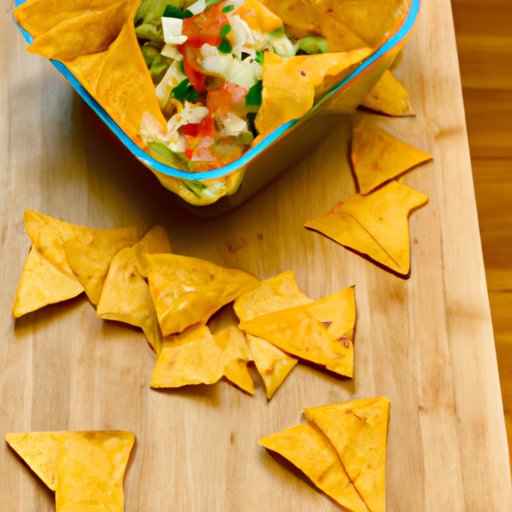Introduction
Nachos are a delicious snack made with tortilla chips, melted cheese, jalapeno peppers, and various other ingredients. They originated in Mexico in 1943, but have since become an international favorite. But the question remains: Are nachos healthy? In this article, we will explore the nutritional profile of nachos, analyze their health benefits and risks, and explore how to make them healthier. We will also discuss how to include nachos in a balanced diet.
Exploring the Nutritional Profile of Nachos
When it comes to understanding whether nachos are healthy, it’s important to look at their nutritional profile. According to the USDA, a one-ounce serving of nachos contains approximately 120 calories, 5 grams of fat, 17 grams of carbohydrates, and 4 grams of protein. Additionally, this serving provides 1 gram of fiber and 4% of the Daily Value (DV) for calcium.

Analyzing the Health Benefits of Nachos
Nachos can provide some health benefits due to their high fiber and protein content. Dietary fiber is essential for digestive health, as it helps keep you regular and can reduce the risk of certain diseases, such as colon cancer. Additionally, protein is essential for muscle repair and growth, and can help you feel full longer.
Nachos also contain antioxidants, which are compounds that help protect your cells from damage caused by free radicals. Free radicals are molecules that can cause oxidative stress, which is linked to chronic diseases, such as heart disease and cancer. Therefore, consuming foods that are rich in antioxidants can help protect your body from these conditions.
Examining the Health Risks of Eating Nachos
Although nachos can provide some health benefits, they also come with some risks. One of the main concerns with nachos is their high fat content. A one-ounce serving of nachos contains 5 grams of fat, which is 8% of the DV. While some fats are beneficial, most of the fat in nachos comes from unhealthy sources, such as saturated fat and trans fat.
Additionally, nachos are high in sodium. A one-ounce serving of nachos contains 180 milligrams of sodium, which is 8% of the DV. Consuming too much sodium can lead to high blood pressure, which can increase your risk of stroke and heart attack.

Comparing Nacho Calories to Other Popular Snacks
Calorie-wise, nachos are comparable to other popular snacks. A one-ounce serving of nachos contains 120 calories, while a one-ounce serving of potato chips contains 150 calories and a one-ounce serving of popcorn contains 120 calories. Therefore, nachos are not necessarily more calorie-dense than other snacks.

Investigating the Healthiest Ways to Prepare Nachos
If you’re looking to make nachos healthier, there are several things you can do. First, opt for low-fat ingredients, such as low-fat cheese and lean ground beef. You can also choose whole wheat tortilla chips, which are higher in fiber and lower in calories than regular tortilla chips.
Finally, consider skipping the cheese altogether. Cheese is high in calories and saturated fat, so if you’re looking to reduce the fat and calorie content of your nachos, leaving out the cheese is a good option. Instead, opt for flavorful toppings, such as jalapenos, salsa, and guacamole.
Exploring the Role of Nachos in a Healthy Diet
It’s important to remember that nachos should be enjoyed in moderation. As registered dietitian Julie Upton, MS, RD, of Appetite For Health explains, “Nachos can be part of a healthy diet when eaten in moderation. As long as you’re mindful of portion sizes, nachos don’t have to be off limits.”
It’s also important to look at the big picture. If you enjoy nachos once in a while, that’s perfectly fine. However, if you’re eating nachos regularly, it’s important to balance them out with other healthy foods. This means eating plenty of fruits, vegetables, whole grains, and lean proteins throughout the day.
Conclusion
In conclusion, nachos can be part of a healthy diet when eaten in moderation. It’s important to pay attention to the nutritional profile of nachos, as well as the ingredients used to make them. Additionally, it’s important to look at the big picture and make sure you’re eating a variety of healthy foods throughout the day.
(Note: Is this article not meeting your expectations? Do you have knowledge or insights to share? Unlock new opportunities and expand your reach by joining our authors team. Click Registration to join us and share your expertise with our readers.)
